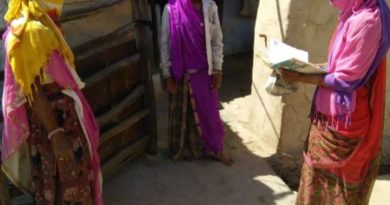New Study Highlights the Threats of Illegal Ritualistic Hunts in West Bengal
A new study highlights the grave impacts of illegal ritualistic hunts in West Bengal, India, where thousands of hunters gather during cultural or religious festivals to kill wildlife using traditional weapons such as bows, catapults, and spears. The research involved socio-economic questionnaires carried out with 99 hunters from hot spot areas and reveals that these large-scale social events impact more than 90 different species, including some already at risk of extinction, while posing significant challenges for animal welfare.
Animals killed in ritualistic hunt Photograph HEAL
The hunts, which are conservatively estimated to result in the deaths of 5,000 animals annually, target species ranging from wild boars and Bengal monitors to jungle cats, Indian flying foxes and greater coucals. Among these, seven species are listed as globally threatened on the IUCN Red List, including the Critically Endangered elongated tortoise and long-billed vulture. Additionally, 25 species fall under Schedule I of India’s Wildlife Protection Act, making their killing illegal under all circumstances.
The study also explored the motivations driving hunters. Wild meat consumption remains central to these events, often as part of celebratory feasts. However, some species, such as Bengal monitors, are also hunted for their skin, bones, and fat for use in traditional medicine or decorative items. Economic trade in wildlife derivatives was reported by a smaller proportion of hunters. Notably, personal enjoyment, rather than economic gain or subsistence use, emerged as the primary motivation for participating in the hunts.
Despite the scale of the issue, the study underscores opportunities for change. The authors call for strengthening law enforcement alongside targeted awareness campaigns to help communities transition toward sustainable practices, ensuring the preservation of both cultural traditions and West Bengal’s unique wildlife. Additionally, they recommend involving local stakeholders in the development of wildlife-friendly initiatives, offering a practical pathway to protect biodiversity while fostering community pride.
Dr Neil D’Cruze, lead author and Head of Wildlife Research at World Animal Protection, said, “Every year these large ritualistic hunts are a devastating blow for both local biodiversity and animal welfare. They typically involve thousands of hunters, leading to the estimated indiscriminate killing of at least 5,000 wild animals annually. Among the species most at risk are the Critically Endangered elongated tortoise, slender-billed vulture, and long-billed vulture, whose populations are already in steep decline. Beyond the staggering loss of threatened species, the methods used-such as spears, catapults, and bows-inflict immense suffering on animals, many of whom are left to die slow, painful deaths. The scale of animal suffering and its impact on ecosystems cannot be overstated.”
Shubhobroto Ghosh, Co-author of the study and Wildlife Projects Manager at World Animal Protection India, said, “While ritualistic hunting may have deep cultural roots, it is illegal under Indian law. The Wildlife Protection Act, 1972, strictly bans hunting of Schedule I species, including the Critically Endangered long-billed vulture and elongated tortoise, granting them the highest protection. Our study, however, offers hope: these hunts are largely motivated by personal enjoyment rather than subsistence. Encouragingly, most hunters expressed interest in legal alternatives like wildlife-friendly tourism or nature-based festivals, which could sustain cultural traditions while safeguarding wildlife and instilling pride in the region’s rich biodiversity.”
Gajender Sharma, Director of World Animal Protection India, said, “This study is not just about documenting a problem but finding solutions. The success of community-led conservation initiatives, such as the Khonoma Nature Conservation Sanctuary in Nagaland, shows what’s possible when people and wildlife thrive together. By offering wildlife friendly alternatives like wildlife photography, birdwatching, and eco-tourism, we can address hunters’ motivations for enjoyment while creating new opportunities. With combined efforts in law enforcement and community engagement, a positive transformation for both wildlife and people in West Bengal is achievable.”
Notes to Editors
For further information
Shubhobroto Ghosh, Wildlife Research Manager, World Animal Protection
Email: shubhobrotoghosh@worldanimalprotection.org.in
+91 (0) 9953 965 242
Bev Boyle, Head of Media, World Animal Protection
Email: Bevboyle@worldanimalprotection.org
+44 (0) 7968 415 856
Source
D’Cruze N, Elwin A, Ghosh S, Asfaw AE, Coulthard E, Megson D, Norrey J, Giri S, Mishra V, Adhya T, Chatterjee S, Banerjee M, Banerjee A, Harrington L (2024) Ritualistic hunts: exploring the motivations and conservation implications in West Bengal, India. Nature Conservation 56: 243-273.
Link to Open Access paper www.natureconservation.56.132178
Seven impacted species are categorised on the IUCN Red List as threatened:
Critically Endangered elongated tortoise
Critically Endangered long billed vulture
Critically Endangered slender billed vulture
Vulnerable common pochard
Vulnerable swamp francolin
Vulnerable pale capped pigeon
This research represents a collaboration between researchers affiliated with World Animal Protection, the Human and Environment Alliance League (HEAL), Manchester Metropolitan University (MMU), and the University of Oxford, Wildlife Conservation Research Unit (WildCRU).
About World Animal Protection
World Animal Protection is the global voice for animal welfare, with more than 70 years of experience campaigning for a world where animals live free from cruelty and suffering. We have offices in 12 countries and work in 47 countries. We collaborate with local communities, the private sector, civil society, and governments to improve the lives of animals. Our goal is to change the way the world works to end animal cruelty and the suffering of wild and farmed animals. Through our global food system strategy, we will end factory farming and create a humane and sustainable food system that puts animals first. By transforming the failed systems that fuel exploitation and commodification, we will give wild animals the right to a wild life. Our work to protect animals will play a vital role in solving the climate emergency, the public health crisis, and the devastation of natural habitats.
About Human and Environment Alliance League
Indias vast ecological richness and diverse life forms are confronting a myriad of challenges. Wildlife faces unprecedented exploitation and is declining rapidly. Life-sustaining ecosystems are losing their integrity due to short-sighted policies driven by an insatiable desire for commercial profits. To address these critical conservation challenges, a group of passionate young individuals from Kolkata, came together and formed HEAL in 2017. Conservation problems are seldom straightforward, and HEALs approach to solving them is anything but ordinary. Embracing a multipronged strategy, we craft interventions that encompass scientific research, communities engagement through transformative programs, wildlife, and environmental crime investigations, liaising with enforcement authorities and policymakers, and filing of Public Interest Litigations in pursuit of environmental justice. We believe not only in enforcing laws but also in shaping policies that ensure a sustainable balance between human activities and the preservation of our unique ecosystems.
About Manchester Metropolitan University
Manchester Metropolitan University has a driving ambition to discover and disseminate knowledge, to make higher education accessible and beneficial to all those with the passion and ability to succeed.
About Wildlife Conservation Research Unit
A University of Oxford first, founded in 1986, WildCRU was the first university-based conservation research unit in Europe. Today we are recognised as a world leader in our field.
Photos
Photos to accompany the release are available at this link.



